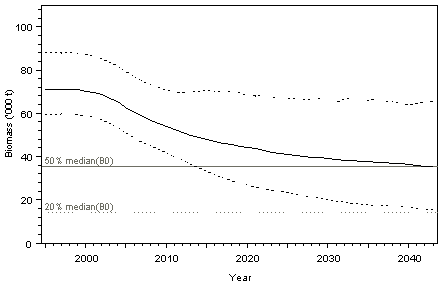Jurisdictional framework
Management Body/Authority(ies):
Mandate: Management; Scientific Advice.
Area of Competence: CCAMLR area of competence
Maritime Area: High Seas.
Status of Management
Assessment Summary
Resources Assessed
Toothfish - Southern Ocean, 2008
Fishery assessments are founded on Article II of CCAMLR's Convention which embodies ecosystem-based fishery management and the precautionary approach (see
http://www.ccamlr.org/pu/e/e_pubs/bd/pt1.pdf). CCAMLR aims to regulate fishing on target species while ensuring that harvesting does not adversely impact other species that are related to, or dependent on, the target species.
Article II is implemented by a 3-part decision rule where yield is a proportion (gamma) of the pre-exploitation biomass. The decision rule for toothfish is: Part 1 (the recruitment criterion) - Choose a yield (gamma1) so that the probability of the spawning biomass dropping below 20% of its median pre-exploitation level over a 35-year harvesting period is 10%; Part 2 (the predator criterion) - Choose a yield (gamma2) so that the median escapement at the end of a 35 year period is 50% of the median pre-exploitation level; and Part 3 – Select the lower of gamma1 and gamma2 as the yield. CCAMLR's Working Group on Fish Stock Assessment conducts annual assessments based on the best available scientific information including fishery, observer, research and compliance data (see
http://www.ccamlr.org/pu/e/e_pubs/fr/drt.htm). CCAMLR's Scientific Committee reviews each assessment and develops management advice.
A Bayesian sex and age structured population model was used to assess
D. mawsoni in Subareas 88.1 and the western sector of Subarea 88.2 (small-scale research units A and B). The model was fitted to CPUE indices, catch-at-age data, and tag-recapture data from the fishery. Overall, model fits to the data are adequate, with the tag-release and recapture data providing the most information on stock size. The Monte-Carlo Markov Chain (MCMC) estimate of initial (equilibrium) spawning stock abundance (B
0) for the model was 71200 tonnes (95% credible interval: 59570–87900 t), and the current biomass was estimated as 82% of B
0 (Figure 2). The yield for the fishery was estimated using the 3-part decision rule.
 |
| Figure 2 Estimated spawning stock biomass median (solid line) and 95% credible interval (dashed lines) for the base-case assessment of Dissostichus mawsoni in Subarea 88.1 and the western sector of Subarea 88.2. |
Management Regime
The fishery is in an exploratory phase and is subject to a notification procedure within CCAMLR's regulatory framework for managing fisheries (see
CCAMLR Conservation Measure 21-02).
The operation of fishing gear is strictly regulated and vessels must comply with CCAMLR's mitigation measures which minimise the attraction of seabirds to fishing vessels and reduce the risk of birds seizing baited hooks, particularly during the period when the lines are set (see Conservation Measure 25-02).
Fishing vessels must also report potential encounters with vulnerable marine ecosystems (VMEs). Vessels which exceed a threshold of VME-indicator organisms per longline line segment (5 or more VME-indicator units) must notify the encounter to the CCAMLR Secretariat (see Conservation Measure 22-07, see also
http://www.ccamlr.org/pu/E/sc/fish/forms.htm). Risk areas are declared where 10 or more VME-indicator units are recovered from a single line segment, and these areas shall remain closed to bottom fishing until they have been reviewed by CCAMLR's Scientific Committee and management actions are determined by the Commission. In addition, fishing is prohibited in depths shallower than 550 m in order to protect benthic communities.
Vessels operating in this fishery are also subject to a by-catch move-on rule: If the by-catch of any one species is equal to or greater than 1 tonne in any one haul or set, then the fishing vessel is required to move to another location at least 5 nautical miles distant, and the vessel can not return to any point within 5 nautical miles of the location where the by-catch exceeded 1 tonne for a period of at least five days. Vessels catching macrourids may also be required to cease fishing in a small-scale research unit if the catch of macrourids reaches a specified threshold within a given time period.
Each vessel participating in the fishery is required to carry at least two scientific observers, one of whom is appointed in accordance with the CCAMLR Scheme of International Scientific Observation, on board during all fishing activities.
Vessels must also conduct fishery-based research to collect detailed biological data on the target and by-catch species, and to tag and release Dissostichus spp. at a specified rate per tonne green weight caught.
Flag States must report catches and fishing effort in accordance with CCAMLR's real-time Catch and Effort Reporting System, and detailed catch and effort data on a haul-by-haul basis. Vessels are tracked using CCAMLR's centralised Vessel Monitoring System, and all transhipments, landings and trade of Dissostichus spp. are logged using CCAMLR's Catch Documentation Scheme.
Most toothfish fisheries have also been targeted at various times by IUU fishing activities. IUU fishing undermines CCAMLR's management objectives by threatening the sustainability of toothfish stocks and seabird populations which are prone to IUU activities. In response, CCAMLR has developed a set of integrated measures to combat IUU fishing. These measures include a Catch Documentation Scheme to monitor landings and the global trade of toothfish, strict vessel licensing requirements, at-sea and port vessel inspections, a comprehensive list of IUU vessels and the development of a centralised Vessel Monitoring System (see Conservation Measures 10-01 to 10-09).
CCAMLR reviews the management advice for each fishery annually, and updates the schedule of Conservation Measures in force which regulates fisheries in the CCAMLR Convention Area. The fishery for toothfish in Subarea 88.1 is managed under Conservation Measure 41-09 and associated measures.





